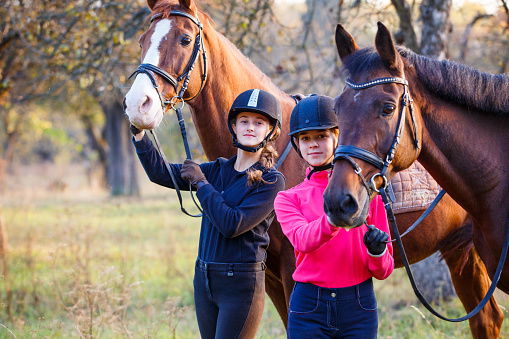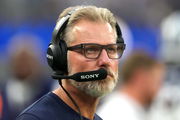
Imago
Two teenage girls with their horses in autumn park. Equestrian sport background with copy space

Imago
Two teenage girls with their horses in autumn park. Equestrian sport background with copy space
Equestrian sports have run through hundreds of years to bear an ever-evolving view. The changes in the format have hardly ever kept the sport away from prejudice of the outsiders, forming an intricate web of difference. However, not all notions stand to be dismissed as assumptions. The surrounding web, at times, holds the truth of barriers that push the practice away from aspirants.
Watch What’s Trending Now!
Equestrian sports are a celebration of skills, grace, and agility beyond a doubt. The gleaming bond with the equine only further adds to the sport’s highlight. However, a minor step on the wrong side of these factors sets the field up for challenges. From elitism to well-being concerns, the sport has a lot to bear.
ADVERTISEMENT
The hurdles faced by equestrian sports
Equestrian sports have quite the field to offer. According to FEI, the organization recognizes 8 disciplines in total. However, only 3 of them (Jumping, Dressage and Eventing) make it to the Olympics, with the rest (Driving, Endurance, Vaulting, Reining and Para-Equestrian) highly focused on grassroots levels. Nature of the flow or a chain reaction, the 3 disciplines are recognized widely, demand and issue massive money. According to Business Insider, the cost of maintaining a horse can easily reach tens of thousands of dollars a month. These factors, inclusive of resources and maintenance, primarily pull wealthy families in for participation; highlighting the lack of diversity.

ADVERTISEMENT
Years into evolved attitudes and ethics, the equestrian sport remains one to lack diversity larger than most. Be it in gender or communities, there exists a visible difference. According to the United States Equestrian Federation (USEF), the members’ profiles read: an average net worth of $955,000 where 40% own a farm; 66% of those are 10 acres or more. Further, while the race and ethnicity demographics are said to have been witnessing a tracking even if recently, for athletes of color, the practice has been non-existent because of the low numbers. When one stands to identify social differences, observing human athletes, the challenges extend beyond in care of equines for the sport.
ADVERTISEMENT
The involvement of animals always holds the probability of mistreatment, which isn’t easy to gulp. Use of equipment, training methods, the wrong amount of pressure, all contribute to the distress for the animal. The practices have further evoked a response from animal welfare organizations asking for the sport to be withheld from the Olympics. While the problems hold no exact solutions, there have been measures taken to curb the barriers while garnering social acceptance.
Top Stories
Cowboys Fire Defensive Coordinator Matt Eberflus: Contract, Salary, NFL Earnings & More

Ross Chastain Labels NASCAR Driver “The Most Punchable Face” to Excuse Himself Over Punchgate Controversy

10 Biggest NFL Draft Busts of the Last Decade, Including Trey Lance and Justin Fields

Andy Reid Sets Record Straight on Travis Kelce’s Chiefs Future As Retirement Question Continue to Mount

Commissioner Steve Phelps Quits NASCAR Days After Getting Exposed in Lawsuit Trial

Arman Tsarukyan Back in Play as Justin Gaethje Staph Infection Rumors Causes Fan Panic Before Paddy Pimblett Fight

A way to break the glass ceiling
One way to increase inclusivity in the sport would be to make the field accessible to as many people as possible. In its first step, US Equestrian has set forth projects with grants, scholarships, and tutorials easily available. Emerson Burr Horsemanship Fund is one of the first ones on the list to offer grants for young enthusiasts. A simple test of knowledge and the individuals will be awarded the grant based on the results. National Youth Sportsman’s Award to recognize youngsters and Scholarships for graduating High School Seniors are some other projects under USE.
ADVERTISEMENT
Also Read: Does Equestrian Truly Embrace Inclusivity as a Sport?
Taking it a step further, the British Equestrian has pledged to improve equality, diversity, and inclusion throughout the industry. The organization aims to promote the benefits equestrian sports have to offer and reach various communities. “Equestrianism and the passion for horses is by its nature hugely diverse and open to all, regardless of age, gender, religion, ability or background,” said Chief Executive of British Equestrian Jim Eyre. He further added that he is aware of the under-representation of other communities and hopes for the project to embrace and recognize differences.
The committee ultimately aims to understand the perceptions of people across various communities and understand their reason for non-participation. Lastly, Jim Eyre conveyed sincerity for the industry hopefuls with a wish to open up. “If we are to thrive as an industry and open up participation for everyone to experience the unique joy horses bring, we have to do more to embrace our differences and recognize what can be possible when equality, diversity, and inclusion is woven into our culture.”
ADVERTISEMENT
Watch this story: 2022 KENTUCKY DERBY TRIUMPHANT WITHDRAWN FROM HORSE SALE DUE TO SADDENING HEALTH AFFAIR
ADVERTISEMENT
ADVERTISEMENT
ADVERTISEMENT

